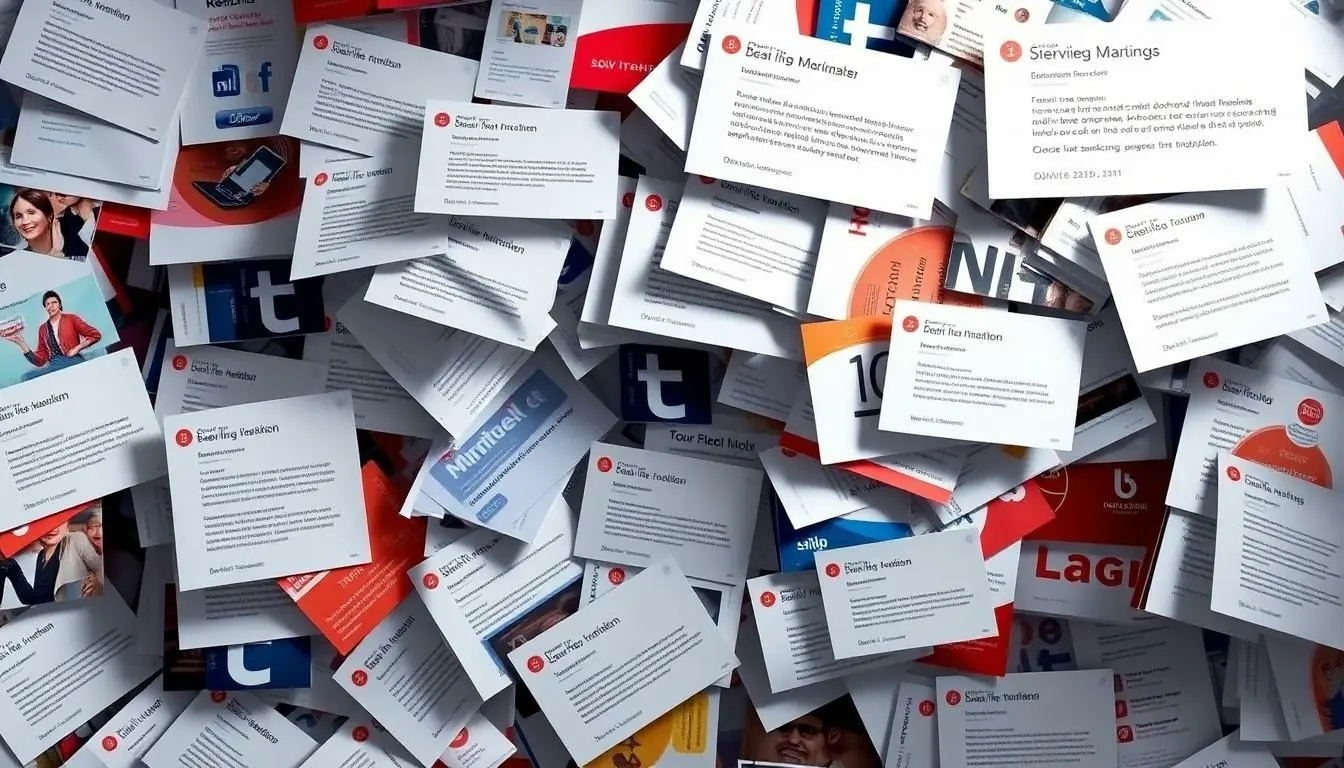Table of Contents
ToggleIn a world where marketing technology is supposed to make life easier, why does it feel like spam’s taken over? Picture this: you’re sifting through your inbox, dodging unwanted offers like a pro at a dodgeball tournament. The martech landscape is brimming with tools and solutions, yet spam remains the uninvited guest that just won’t leave the party.
As companies scramble to harness the power of martech, they’re often left wondering how to separate the gold from the glitter. With spam tactics evolving faster than a cat meme going viral, it’s crucial to stay informed about the latest trends and strategies in this chaotic realm. Buckle up as we dive into the martech outlook, exploring how to keep your inbox clean and your marketing efforts effective.
Overview of Martech Outlook Spam
Martech outlook spam manifests as an influx of unwanted communications that obstruct effective marketing efforts. Companies adopting marketing technology tools often find their inboxes flooded with promotional offers that detract from genuine customer interactions. The challenge to manage diese distractions increases as marketing technologies evolve and new strategies emerge.
Spam tactics show rapid adaptation alongside advancements in martech. Organizations face the dual task of leveraging valuable marketing insights while combating an aggressive spam environment. Sophisticated techniques aim to bypass filters, often targeting those utilizing email as a primary marketing channel.
Understanding the landscape requires awareness of the various forms of spam making the rounds. Promotional offers, unsolicited proposals, and blatant phishing attempts contribute to a disorganized inbox. Recognizing these patterns helps marketers develop strategies to clean up their email communications.
Striking a balance between effective marketing and spam avoidance remains crucial. An effective marketing strategy often includes best practices such as segmenting email lists to ensure relevant offers reach interested recipients. These steps reduce the chances of being flagged as spam and help maintain a healthy sender reputation.
Effective monitoring and analytical tools can enhance spam detection. Metrics such as open rates and engagement levels offer insights into the performance of marketing campaigns. Utilizing these analytics allows organizations to refine their approaches, ensuring that genuine messages resonate with their audience while minimizing spam-related issues.
Understanding Spam in Marketing Technology

Spam in marketing technology refers to the influx of unwanted communications that disrupt effective marketing efforts. Organizations face significant challenges in distinguishing valuable messages from spammy content amidst the noise created by various martech tools.
Definition of Spam
Spam encompasses unsolicited messages sent en masse, often cluttering inboxes and hindering productive communication. This digital clutter varies widely, including promotional emails, irrelevant advertisements, and deceptive phishing attempts. Formally, spam can be defined as any unwanted digital content delivered primarily through email or messaging platforms. Identifying spam is crucial in maintaining effective customer engagement and ensuring valuable marketing strategies yield results.
Types of Spam in Martech
In the martech landscape, various types of spam emerge that organizations must confront. Promotional spam inundates inboxes with irrelevant offers, often lacking personalization or context. Additionally, phishing attempts masquerade as legitimate communications, designed to steal sensitive information from recipients. Content farms create low-quality articles for SEO purposes, further contributing to the noise. Other spam types also include bot-generated messages and fake reviews that damage brand reputation. Recognizing these diverse forms of spam helps organizations develop tailored strategies to clean up their communications and better connect with their target audience.
Impact of Martech Outlook Spam
Martech outlook spam presents significant challenges for organizations. Companies often experience disruptions in their operations due to the overwhelming influx of unwanted messages.
Effects on Businesses
Businesses face decreased productivity as employees sort through irrelevant emails. Prioritizing communication becomes difficult when spam occupies inboxes, leading to missed opportunities. Customers may feel frustrated by constant promotional offers. Effective brand engagement suffers when potential leads are lost in spam filters. Companies also incur additional costs related to email management and improved spam detection systems. The overall reputation can suffer as clients perceive brands poorly when they overwhelm their inboxes with unwanted messages. Organizations that fail to tackle this issue risk alienating their audience.
Consequences for Marketing Professionals
Marketing professionals experience challenges in maintaining effective campaigns amidst rising spam levels. Trust with recipients diminishes when marketing emails blend with unsolicited messages. Campaign metrics may show skewed results because spam can inflate unsubscribe rates, leading to inaccurate data. Creativity in crafting unique messages becomes essential, taking extra effort in a crowded market flooded with irrelevant content. Professionals also face the daunting task of adjusting strategies continuously to combat evolving spam tactics. Keeping up with regulatory compliance adds to the stress for marketing teams wrestling with effective communication strategies.
Strategies to Combat Martech Outlook Spam
Organizations must implement effective strategies to combat martech outlook spam, focusing on both detection and prevention. Employing various techniques can enhance email communication while minimizing unwanted messages.
Email Filtering Techniques
Utilizing advanced email filtering technologies significantly improves spam detection. Filters based on keywords, sender reputation, and user behavior can identify potential spam. Companies often use machine learning algorithms to analyze communication patterns, adapting filters to new spam tactics quickly. Implementing whitelists and blacklists enables organizations to allow trusted senders while blocking known spammers effectively. Regularly updating filter settings ensures adaptation to evolving spamming methods, maintaining the inbox’s integrity.
Best Practices for Prevention
Adopting best practices plays a crucial role in preventing spam from infiltrating email communications. Segmenting email lists allows marketers to target specific audiences with relevant content, reducing the chances of being marked as spam. Personalizing messages enhances engagement, making recipients less likely to view emails as irrelevant. Encouraging users to opt-in for newsletters or updates fosters a consent-based relationship. Maintaining compliance with regulations, such as GDPR and CAN-SPAM, protects organizations from hefty fines while building trust with consumers.
Navigating the landscape of martech outlook spam is crucial for organizations aiming to enhance their marketing efforts. As spam tactics evolve, companies must stay vigilant in identifying and managing unwanted communications. By employing effective strategies like advanced filtering and personalized messaging, businesses can significantly reduce spam interference.
Emphasizing consent-based relationships and regulatory compliance not only builds trust with consumers but also protects organizations from potential penalties. In this dynamic environment, the ability to adapt and refine marketing strategies will be key to maintaining productive customer interactions and achieving long-term success.




